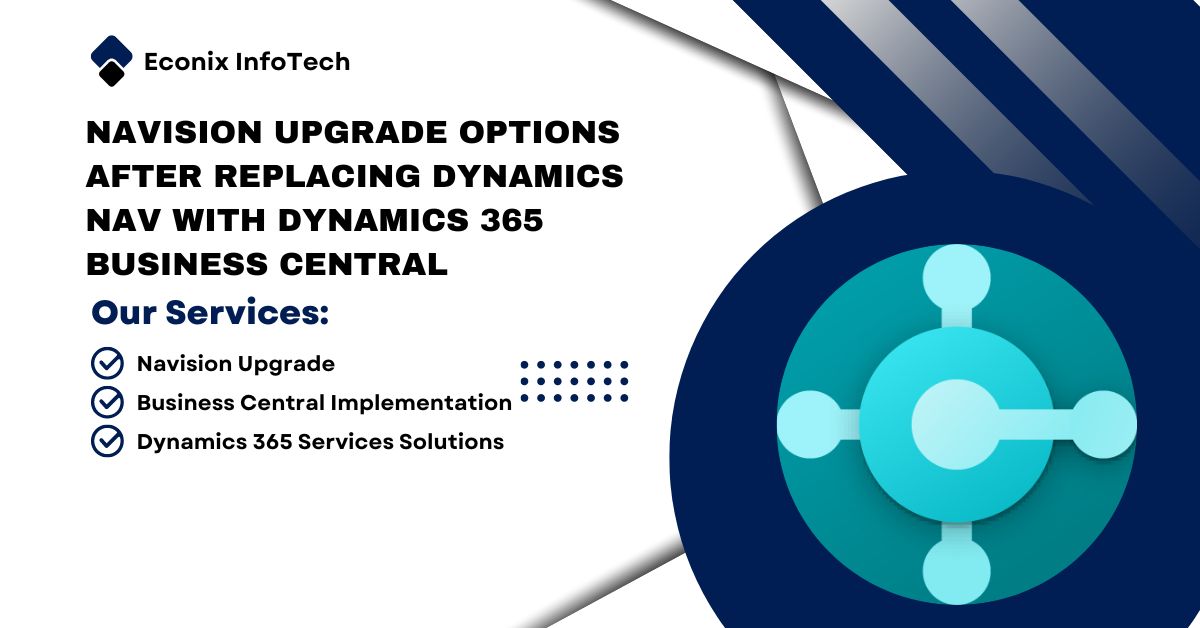Navision Upgrade Options after Replacing Dynamics NAV with Dynamics 365 Business Central

Introduction
The transition from Microsoft Dynamics NAV to Dynamics 365 Business Central has brought significant changes to the world of enterprise resource planning (ERP) systems. With the release of Dynamics 365 Business Central, organizations using the legacy Navision system are faced with the question of how to proceed. This blog post will explore the various upgrade options available to businesses after replacing Dynamics NAV with Dynamics 365 Business Central, providing insights into the potential benefits, challenges, and considerations associated with each option.
Option 1: Full Cloud Migration
One of the key advantages of Dynamics 365 Business Central is its cloud-native architecture, which offers enhanced scalability, flexibility, and accessibility. A full cloud migration involves moving the entire ERP system from an on-premises environment to the cloud. This option offers several benefits, such as reduced infrastructure costs, automatic updates, improved security, and simplified maintenance. However, it requires careful planning and considerations regarding data migration, integration with other systems, and potential customization requirements. Organizations opting for a full cloud migration should assess their readiness, evaluate the impact on existing processes, and ensure adequate training for employees.
Option 2: Hybrid Approach
For organizations that prefer a gradual transition or have specific requirements that necessitate on-premises components, a hybrid approach can be a viable upgrade option. This approach involves maintaining some components of the ERP system on-premises while leveraging the cloud capabilities of Dynamics 365 Business Central for specific functionalities. This option allows organizations to benefit from the cloud’s scalability and flexibility while retaining control over critical aspects of their infrastructure. It also provides an opportunity to gradually migrate specific modules or functionalities to the cloud, minimizing disruption and risk. However, it requires careful planning to ensure seamless integration between on-premises and cloud components, as well as ongoing management of hybrid environments.
Option 3: Reimplementation
Another upgrade option is to undergo a complete reimplementation of the ERP system using Dynamics 365 Business Central. Reimplementation involves redesigning and reconfiguring the system to align with the new platform’s functionalities, taking advantage of the improved features and capabilities. This option allows organizations to streamline their processes, optimize workflows, and leverage the latest technology. However, reimplementation can be a time-consuming and resource-intensive process, requiring a thorough understanding of existing business processes and data structures. It also offers an opportunity to reassess business requirements, eliminate unnecessary customizations, and adopt best practices.
Option 4: Upgrade and Customize
For organizations that heavily rely on customized functionalities in their Navision environment, upgrading and customizing Dynamics 365 Business Central may be the most suitable option. This involves upgrading the existing system to the latest version and then customizing the new platform to replicate the desired functionalities. While this approach allows businesses to maintain their unique workflows and processes, it requires careful evaluation of the existing customizations and their compatibility with the new platform. It is essential to assess the feasibility of replicating customizations and consider alternative solutions offered by Dynamics 365 Business Central. Additionally, organizations must plan for ongoing maintenance and support of the customized functionalities to ensure compatibility with future platform updates.
Conclusion
The transition from Dynamics NAV to Dynamics 365 Business Central presents organizations with multiple upgrade options. Each option has its own advantages, challenges, and considerations that should be carefully evaluated based on the organization’s unique requirements and circumstances. Whether opting for a full cloud migration, a hybrid approach, a complete reimplementation, or an upgrade with customization, organizations should prioritize thorough planning, stakeholder involvement, and training to ensure a successful transition.
By embracing the new capabilities of Dynamics 365 Business Central, organizations can leverage modern cloud technologies, enhanced features, and improved integration capabilities to drive operational efficiency, improve decision-making, and achieve greater agility in an ever-evolving business landscape. It is crucial to work closely with experienced consultants and leverage their expertise to guide the upgrade process and maximize the benefits of the new ERP system. With careful planning and execution, the upgrade from Navision to Dynamics 365 Business Central can position organizations for long-term success and enable them to stay ahead in the digital transformation journey.
LATEST INSIGHTS
-
Business Central customize pages for profiles
-
Adding Regional Formats to Reports in Dynamics 365 Business Central
-
Dynamics 365 Business Central – How to create Sell Products with a Customer Sales Order
-
Cash Flow in Dynamics Business Central Overview
-
Understand Location cards in D365 Business Central
REQUEST
FOR A CALL BACK
Provide discussion information and we’ll get back to you as soon as possible
Customer Satisfaction
Address
Corporate Office
Econix InfoTech Ltd.
10B-111 REGINA RD, WOODBRIDGE, ON L4L 8N5, Canada
Request a Business Consultation
Subscribe Newsletter
Copyright© 2018-2024 ECONIX InfoTech & Group Companies. All Rights Reserved



